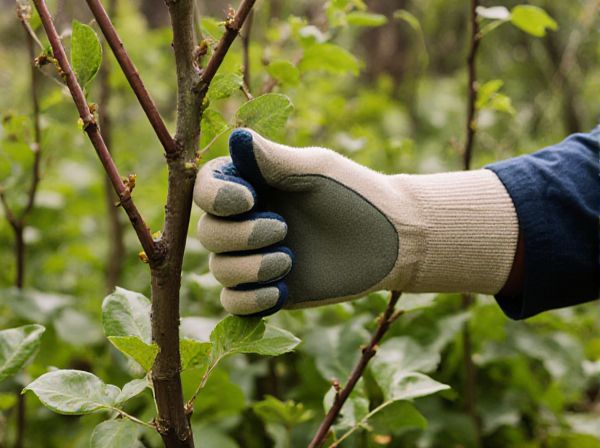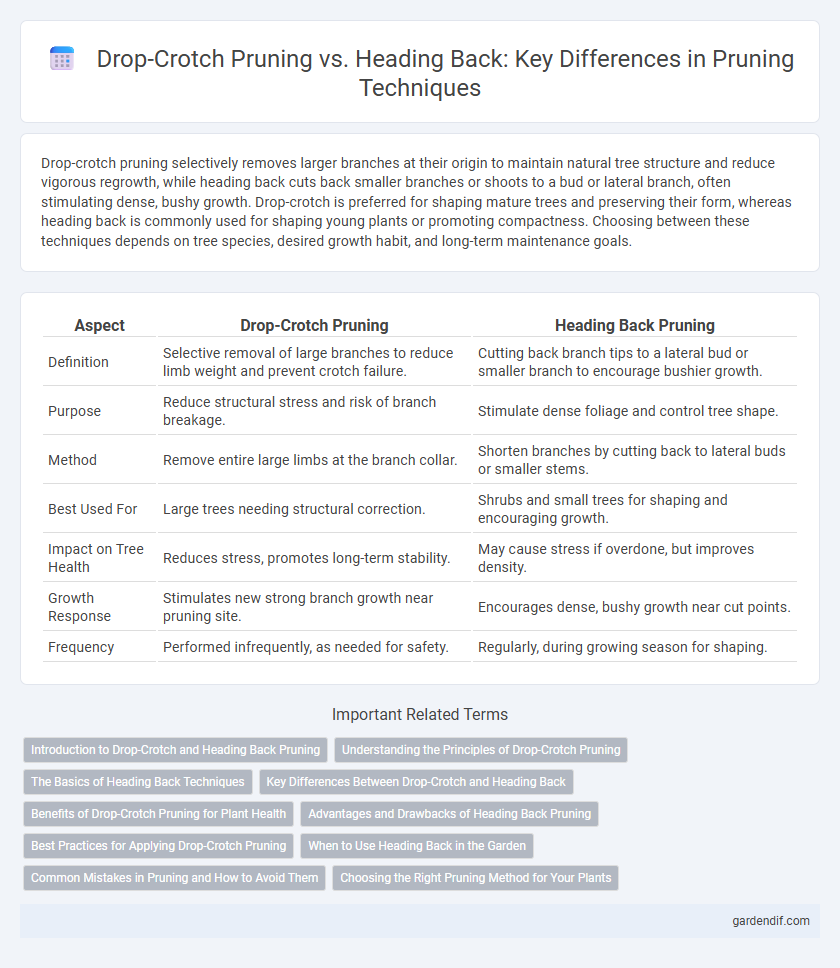
Drop-crotch pruning vs heading back Illustration
Drop-crotch pruning selectively removes larger branches at their origin to maintain natural tree structure and reduce vigorous regrowth, while heading back cuts back smaller branches or shoots to a bud or lateral branch, often stimulating dense, bushy growth. Drop-crotch is preferred for shaping mature trees and preserving their form, whereas heading back is commonly used for shaping young plants or promoting compactness. Choosing between these techniques depends on tree species, desired growth habit, and long-term maintenance goals.
Table of Comparison
| Aspect | Drop-Crotch Pruning | Heading Back Pruning |
|---|---|---|
| Definition | Selective removal of large branches to reduce limb weight and prevent crotch failure. | Cutting back branch tips to a lateral bud or smaller branch to encourage bushier growth. |
| Purpose | Reduce structural stress and risk of branch breakage. | Stimulate dense foliage and control tree shape. |
| Method | Remove entire large limbs at the branch collar. | Shorten branches by cutting back to lateral buds or smaller stems. |
| Best Used For | Large trees needing structural correction. | Shrubs and small trees for shaping and encouraging growth. |
| Impact on Tree Health | Reduces stress, promotes long-term stability. | May cause stress if overdone, but improves density. |
| Growth Response | Stimulates new strong branch growth near pruning site. | Encourages dense, bushy growth near cut points. |
| Frequency | Performed infrequently, as needed for safety. | Regularly, during growing season for shaping. |
Introduction to Drop-Crotch and Heading Back Pruning
Drop-crotch pruning involves selectively reducing the length of major branches to maintain structural integrity while encouraging outward growth, minimizing stress and potential damage. Heading back pruning focuses on cutting back the terminal portions of branches to promote dense, bushy foliage and control overall size. Both techniques tailor plant shape and health but differ in their approach to branch reduction and growth stimulation.
Understanding the Principles of Drop-Crotch Pruning
Drop-crotch pruning involves cutting back large scaffold branches to a strong lateral branch or bud, maintaining the tree's natural structure and reducing stress. This method contrasts with heading back, which cuts branches to a smaller stub, often leading to weak regrowth and increased disease risk. Understanding drop-crotch pruning principles improves tree health, encourages proper branch architecture, and supports long-term structural integrity.
The Basics of Heading Back Techniques
Heading back pruning involves cutting branches back to a bud or lateral branch to control size and shape, promoting dense growth and maintaining structural balance. This technique differs from drop-crotch pruning, which targets larger branches or crotches to reduce weight and encourage strong scaffold development. Proper heading back requires precise cuts just above a healthy bud, optimizing the plant's natural growth patterns and ensuring vigorous regrowth.
Key Differences Between Drop-Crotch and Heading Back
Drop-crotch pruning involves selectively cutting main branches back to lateral shoots, promoting natural branch structure and balanced growth, whereas heading back cuts branches back to a bud or stub, leading to denser, more compact growth. Drop-crotch pruning reduces stress on the tree by maintaining branch taper and energy flow, while heading back can cause increased regrowth and potential weak branch formation. Key differences include the impact on tree architecture, growth patterns, and long-term structural integrity.
Benefits of Drop-Crotch Pruning for Plant Health
Drop-crotch pruning promotes healthier plant growth by selectively removing larger branches near the trunk, reducing stress and preventing excessive regrowth commonly caused by heading back. This method encourages natural branch architecture, improves sunlight penetration, and enhances air circulation, significantly lowering the risk of disease and pest infestations. Trees pruned with drop-crotch techniques demonstrate increased structural integrity and long-term vitality compared to those subjected to heading back.
Advantages and Drawbacks of Heading Back Pruning
Heading back pruning encourages denser foliage growth and can control tree size effectively, making it suitable for shaping plants in limited spaces. However, it often leads to weak, rapidly growing shoots susceptible to breakage and may increase the risk of disease due to large pruning wounds. This method requires careful timing and frequent maintenance to avoid long-term damage and promote healthy regrowth.
Best Practices for Applying Drop-Crotch Pruning
Drop-crotch pruning emphasizes maintaining natural branch angles by cutting back to lateral branches at least one-third the diameter of the parent limb, reducing the risk of weak attachments and decay common in heading back. Best practices include making clean, angled cuts just outside the branch collar to promote faster wound closure and prevent diseases. This method enhances tree structure, encourages balanced growth, and minimizes long-term maintenance compared to aggressive heading back techniques.
When to Use Heading Back in the Garden
Heading back is ideal for controlling the size and shape of shrubs and small trees by cutting branches back to a bud or lateral branch, promoting dense, compact growth. Use heading back during the dormant season or early spring before new growth begins to encourage vigorous shoots and maintain structural balance. This technique is especially effective for maintaining formal hedges, encouraging flowering, and managing overgrown plants without drastically altering their natural form.
Common Mistakes in Pruning and How to Avoid Them
Drop-crotch pruning often causes excessive branch stubs that can lead to disease, while heading back may encourage weak, rapidly growing shoots prone to breakage. Common mistakes include indiscriminate cuts and improper timing, which stress trees and reduce their lifespan. To avoid these issues, identify the tree species' natural growth patterns and apply cuts that preserve structural integrity and promote healthy regrowth.
Choosing the Right Pruning Method for Your Plants
Drop-crotch pruning maintains tree structure by selectively cutting large branches back to a lateral branch, promoting natural growth and stability. Heading back removes terminal portions of branches, encouraging dense foliage but can weaken structure if overused. Selecting the right pruning method depends on the plant species, desired shape, and long-term health considerations to ensure optimal growth and resilience.
Drop-crotch pruning vs heading back Infographic

 gardendif.com
gardendif.com